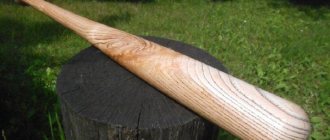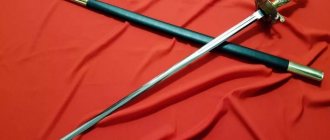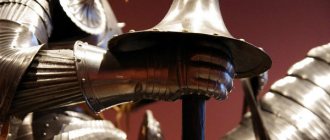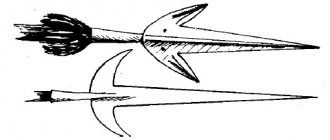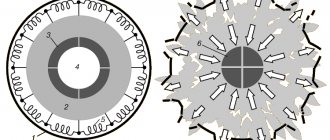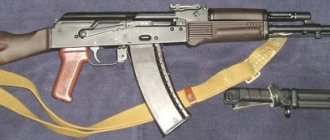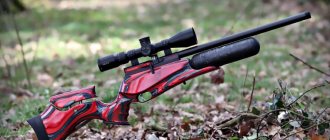The creation of the spear allowed primitive people to rise to a higher level of development; now they could effectively throw it at a target (a light spear or dart was used for this), and keep an animal or enemy at a distance (as a rule, a large spear was used for this).
The creation of the spear has been recorded in various parts of the planet, and it was invented by different cultures independent of each other. At first, all spears were intended for both hunting and combat. After some time, a clear division of these weapons emerged, both by type and by purpose.
Types of copies and their differences from each other
Since ancient times, spears have been divided into the following types:
- Short spear. This weapon could be either light or heavy. A light, short spear intended for throwing. Throwers, as a rule, had several such spears, which were also called darts. These light weapons were intended for distance combat, and the throwers were young warriors who did not yet know how to fight in close combat;
- Long spear. Working with a spear of this type required some experience and strength. Such weapons were used both for hunting (horns) and for combat (hoplite spears, various pikes, and so on);
- Such a specific type of spear, like a harpoon, required much more effort for its manufacture. Harpoons could also be either short or long. Their tips were serrated so that the fish could not slip off. The heavy harpoon was a short spear to which a rope was tied.
Soon hunting and military weapons appeared. The tip of the spear for hunting was wide, and it was sharpened much sharper. Combat models intended for throwing most often had a shifted center of gravity towards the tip. A long spear intended for foot combat (for example, a sarissa) had a narrow tip designed to pierce armor. Also, throwers, along with light spears, widely used mini-spears, which were called darts.
Operating principle of the pilum
The iron tip played a key role in the use of the pilum. It had a hard pyramidal point, but the shaft itself was made of softer iron. This caused the rod to bend after impact, rendering the weapon useless to an opponent who could not use it. However, there were many cases where the entire tip (with shaft) was hardened, making the pilum more suitable for close combat. In addition, if a pilum penetrated a shield, it could become stuck, and thus bending the rod and weighing the shield down with the weight of the pilum made movement difficult and forced the enemy to drop their shield, since removing the pilum was a laborious and slow process. Even if the rod did not bend, the pyramidal tip was still difficult to remove due to its length and the depth of penetration through the shield.
Although the bending of the pilum tip shaft is generally regarded as an integral part of the weapon's design and as a deliberate feature, there is little evidence for this. The most commonly found artifacts indicate that the pilum was designed to use the weight of the weapon to cause damage, most likely to penetrate armor and reach the body of an enemy soldier. Since the weapon was meant to be used against armor, penetrating it using its own weight rather than speed to cause damage, the bending of the rod appears to be a secondary but very useful property.
Most other throwing spears of the time could not penetrate a shield. On the contrary, since the pyramidal tip of the pilum was wider, once it penetrated the shield, it left behind a hole larger than the rest of the rod and passed through the shield with the least resistance, striking the soldier. In addition, when switching to close combat, a legionnaire could step on the shaft with his foot and pull the enemy’s shield down, opening a gap for striking.
History of the development of copies of various types
The first weapons of this type appeared in the Stone Age. It was a simple short spear with a wooden tip, which was simply burned at the stake. This spear tip was extremely unreliable; it had to be renewed after each use.
The next turn in the evolution of this weapon was the appearance of stone tips. Now making a spear required much more effort, since it was not easy to process the stone. Initially, only short, heavy spears were made in this form, since throwing such weapons was impractical. Soon the weapon became much longer, which made it possible to increase the throwing distance.
Along with the development of metallurgy, weapons began to change. Spears with metal tips appeared. At first it was copper and bronze, then iron and steel. Fighting techniques were improved. A long spear could not only stab, it could also do the following:
- The broad tip of the spear cut perfectly;
- Due to the presence of a long shaft, the weapon could make various feints, turns and spirals;
- Experienced warriors fencing perfectly using these weapons, knocking even swords out of the enemy's hands.
The blade of the spear, which was made in the shape of a dagger, made it possible to quickly pull the weapon out of the wound and strike again. A short spear could have a jagged tip, preventing the weapon from being drawn.
Weapon technique
There are a number of scenarios for how the pilum could be thrown. In the first scenario, the entire unit is thrown at the pilum at once. The advantage of this method is the high concentration of projectiles on a relatively narrow section of the front with an effect reminiscent of the quoted passage from Livy. In practice, this scenario turns out to be difficult to implement, since the last row of warriors is located at a distance of about 9 m from the first and turns out to be hardly able to throw their pilum to the enemy without the risk of injuring those in front. In another version of the scenario, instead of “all of a sudden,” the warriors throw pilums in ranks or even individually, approaching the enemy at a certain distance. Finally, another option is the scenario when, at first, the warriors of the first two or three ranks throw their pilums at the enemy, and the rest throw theirs later, during the ensuing battle - either themselves, or passing them on to those in front.
Spear design features
A standard spear consists of two parts:
- Shaft;
- Tip.
The shaft of a standard weapon of this type ranges between 1.5-2.5 meters. However, there were also exceptions to these rules. For example, the ancient Greek sarissa could reach a length of 7.5 meters.
The tips could also be of different lengths. There were tips from 10 to 50 cm. Spears with long tips could easily cut, while shorter and narrower tips were intended for piercing armor. Depending on the purpose, the tips could be of different shapes:
- Leaf-shaped;
- Faceted;
- Subulate and so on.
In Rus', spears were one of the main types of weapons, along with the battle axe.
Archeology about the pilum
Thanks in part to experimental archaeology, it is believed that the pilum design evolved into an armor-piercing one: the pyramidal tip would punch a small hole through an enemy's shield, allowing the thin shaft to penetrate a distance sufficient to wound a person wearing the shield. The thick shaft provided the force of the blow.
There is a description of a modification in which one of the two iron nails holding the iron tip in place was replaced by a weak wooden pin that breaks on impact, twisting the tip's shank sideways. This invention is attributed to Gaius Marius.
Spears of the Ancient World
During the time of Ancient Greece and up until the beginning of the Middle Ages, spears were used in both infantry and cavalry throughout the world. Infantry weapons of that time were represented by spears with both short and long handles. Long versions were used in phalanxes by hoplites, while short models were personal weapons used for both hunting and warfare. Every inhabitant of Ancient Greece had to have such a weapon.
As for the cavalry, they also used both long and short spears. Moreover, the vast majority of cavalry of that time used short weapons. Light cavalry often threw javelins. Each thrower had a large supply of spears. One of the most terrible types of troops of that time were heavy cataphracts, dressed in armor along with horses. They were armed with long two-handed spears.
Historical reference
It is not known exactly when and under what circumstances the Romans first began to use the pilum. It is known that it was used before the 4th century. BC, according to one version, it could have been borrowed from the Samnites, Sabines, or Etruscans, who had darts for fishing vaguely similar to the pilum. One way or another, the Roman army used pilums, initially, apparently, equipping them only with velites (lightly armed and mobile warriors) and hastati (heavily armed warriors).
During the reforms of the commander Gaius Marius (157 - 86 BC), the purpose of which was the reorganization of the legions, the purpose of the scutum also changed - now all legionnaires wore it, and accordingly, both battle tactics and the structure of the pilum itself underwent some changes. Subsequently, the pilum underwent some minor changes, mainly related to the method of attaching the tip to the shaft, changes in weight, and the softness of the metal from which the tips were made. It is believed that each legionnaire carried with him two pilums, varying in weight. By the end of the Roman Empire, the pilum gradually disappeared from the armament of the legions, being replaced by the lighter spiculum, according to Vegetius.
Greek and Roman spears
In Greece, spears have been widespread since ancient times. Initially, throwing spears predominated in this area, since the main occupation of the people was hunting. With the development of civilization and weapons, two schools of spear fighting began to emerge:
- Throwing technique;
- Piercing technique.
The second technique became widespread starting from the Mycenaean period. When the first phalanxes began to appear on the battlefield, a new type of spear appeared, analogues of which appeared only in the late Middle Ages. These were sarissas, the length of which started from 2.5 meters.
The evolution of the phalanx led to the fact that the length of this weapon was increased to 7.5 meters. Naturally, it was impossible to stab with such spears, so the task of the hoplites was simply to point the spear towards the enemy and move forward, pressing on the weapon pierced into the enemy.
As for the ancient Romans, their longest spears were hastas, which were used by triarii spearmen. In addition, each hastati, and later legionnaire, had several throwing pilums. The Vellites and other light support infantry (except archers) had several lighter throwing spears.
The barbarians of Ancient Rome also used light throwing and heavy fighting spears. In addition, it was the barbarian cavalry of some peoples that taught Roman horsemen to use heavy spears in battle.
Origin of the pilum
The origin of the pilum is a matter of debate. Arguments have been made for the invention to belong to the ancient Italic tribes (and possibly the non-Italic Etruscan people), who used the javelin for hunting and fishing. According to another version, the pilum originated on the Iberian Peninsula. Given that there are two versions of the pilum (heavy and light), it is possible that the Roman pilum had two different ancestors from completely different cultures. The two different designs could have been combined to form the typical Roman pilum as it is known today.
Spears of the European Middle Ages
After the Roman Empire fell, All of Europe plunged into the Dark Middle Ages. There is very little information about this time, but one thing can be said for sure: the entire territory of Europe was torn apart by internecine wars. The spear was very popular at this time, as it had the following characteristics:
- Low cost;
- Ease of manufacture;
- Efficiency.
In addition, you can master the basic skills of fighting with a spear in a few days. The troops of all nations, as a rule, were armed primarily with spears. Even the Vikings, who are depicted everywhere with axes, had a huge number of copies for various purposes.
Simple medieval infantry fought primarily with a spear and shield. This weapon is simply impossible to classify, since in England alone there were more than 30 different types and forms of copies. The most famous were throwing spears, which trace their origins to the Roman pilums, and the Viking “winged” spears, which were intended for close combat. There is information that it was this weapon that served as the basis for the famous Swiss halberd.
The length of infantry spears of that time was from 1.8 to 2.5 meters. However, already in the 14th century, a trend of increasing length began to appear, which ultimately led to the appearance of pikes.
During this period, spears for cavalry received a powerful impetus for development. The famous Frankish cavalry demonstrated to the whole world the power of the cavalry spear strike. The appearance of the stirrup and the change in the shape of the saddle greatly contributed to the development of a class of knights who used spears as their main striking weapons. Not a single enemy could withstand the powerful blow of the knight's spear.
However, in the 13th century, the knightly cavalry with heavy spears suffered a serious blow to their pride. The Mongols, who flooded Europe, easily dealt with the clumsy knights using bows and throwing spears.
Bibliography
Bishop, M.C.; Coulston, J. C. N. (2009). Roman Military Equipment from the Punic Wars to the Fall of Rome (2nd ed.). Oxford, UK: Oxford Books;
Connolly, Peter. "The pilum from Marius to Nero: a reconsideration of its development and function", Journal of Roman Military Equipment Studies, vol. 12/13
Zhmodikov, Alexander, 2000, “Roman Republican Heavy Infantrymen in Battle (IV-II Centuries BC),” in Historia: Zeitschrift für Alte Geschichte, vol. 49 no. 1.
JAMES CURLE, FSA SCOT., FSA A Roman frontier post and it's people. The fort of Newstead in the Parish of Melrose. Glasgow, MDCCCCXI. Originally published by JAMES MACLEHOSE AND SONS for the Society of Antiquaries of Scotland.
Renaissance spears
At this time, the gradual decline of the era of these weapons began. Among the infantry, spears practically disappeared, giving way to pikes. The only such weapon left was the Swiss spear, since the Swiss managed to revive the famous Greek phalanx, adjusted for modern times.
But in cavalry, spears remained the main weapon until the 16th century. Around the 1540s, cavalry began to receive pistols, after which lances gradually began to be relegated to a secondary role. However, the making of copies in Eastern Europe continued until the early 20th century. Russian Cossacks with pikes demonstrated in the 20th century that it was too early to write off spears.
The spear is the most common weapon of antiquity. Despite the popularization of the sword, most ancient warriors were armed with spears.
Pugio - dagger
Pugio is an ancient Roman double-edged wide dagger.
These are daggers of various lengths, widths, shapes and materials and methods of manufacture. The length varied from 18 to 30 cm, mostly leaf-shaped, with a blade on both sides and a pointed tip. The handle was made of both metal and wood. Pugio had his own scabbard. What is characteristic of this dagger is that it was worn by many. But it was not a mandatory weapon. Its exact purpose has not yet been clarified. It is believed that some wore it as a decoration, others as an auxiliary weapon in case of loss of the main one.
Provocateur
Gladiator Provocateur
These gladiators did not go into battle with other fighters. Usually fights were arranged only between Provocateurs. They were distinguished by a closed helmet with holes for the eyes, which, as a rule, did not have any decorations. The weapon of the provocateur was a short sword - gladius or a long sword - spatha, the shield was medium in size - rectangular. The only protection was short greaves on the left leg and handcuffs covering the right forearm. The Provocateurs' fighting style consisted of deceptive retreats, provoking the enemy and unexpected counterattacks.
The rise of combat use
Spears and pikes were used almost non-stop at all times, but they showed the greatest effectiveness in antiquity and during the era of the birth of firearms. The firearm solved the main problem of the spear, the low firing range or the inability to reach the enemy at a distance.
From the 16th century, united formations began to form, where warriors armed with arquebuses and muskets were covered by pikemen. The pinnacle of such tactics can be called the tercios, Spanish regiments of combined spear infantry with musketeers and warriors armed with bladed weapons.
Cavalry also actively uses this type of weapon. Light samples and a long knight's spear can be distinguished. The latter were several meters longer than the first and were used to break through enemy infantry formations.
The first, best known as Cossack spears, or otherwise pikes, served not only for thrusting, but also for fencing.
There are many references to how the Cossacks beat enemy horsemen and infantry with pikes.
This also made it possible to use the pike many times, unlike knightly spears, which often broke in the hands. The Cossack spear, unlike the heavy peaks of the regular cavalry, was lighter and shorter.
In total, from the development of the spear and pike the following types of weapons emerged:
- a halberd, a pike with a small hatchet and a hook for pulling the rider off the horse;
- knight's long spear - tournament pike;
- protazan, a spear with a wide blade and a cross to hold the body at the tip;
- a spear, with a shorter tip than the protazan, intended for hunting;
- a trident and a pitchfork, a spear with three or two tips to disarm the enemy.
In addition, there were ersatz spears, such as knives screwed or otherwise attached to a long shaft.
The long spear obtained in this way was often used to arm militia units.
